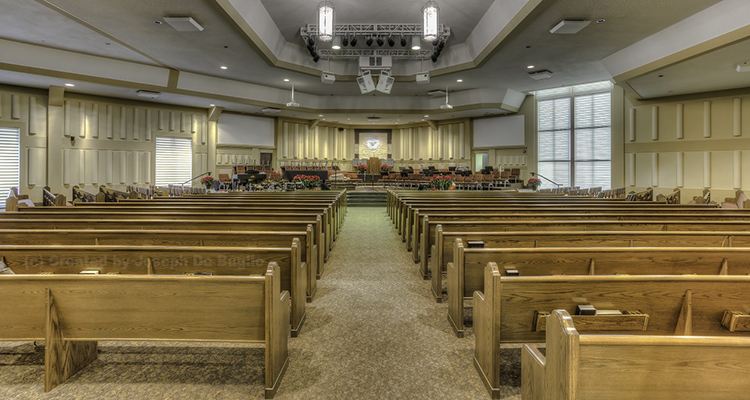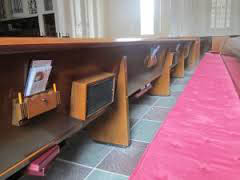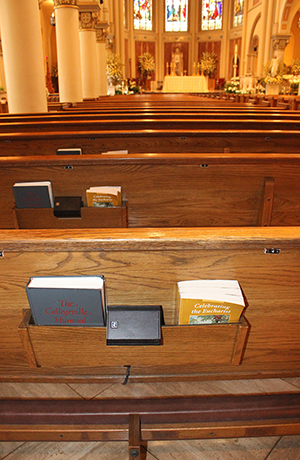Intelligibility and Acoustics: A Conflict Resolved?

Photo courtesy of KV2 Audio.
It’s the Law
The astonishing thing about the laws of physics and the mathematically derived acoustical parameters that govern sound reproduction is that, despite considerable effort by many well meaning or at least well motivated individuals and manufacturers over the last 150+ years, they simply haven’t changed, and, just in case you think there is a breakthrough on the horizon, they won’t change in the next couple of hundred years either. So no matter what you may read, be told or have presented to you, there ARE immutable laws at work here and no product can get around them. Keep that in mind as we proceed!
A Little Useful History
In 1876 (yes… more than 14 decades ago!) Alexander Graham Bell patented his first electric loudspeaker (theoretically questionable of reproducing intelligible speech) as part of his telephone, which was followed a year later in Germany by an “improved version” from the legendary Ernst Siemens (yes, that Siemens).
Two decades later in 1898, Oliver Lodge established the essential parameters for the moving-coil (also called electro-dynamic) loudspeaker design, which is the core DNA from which every loudspeaker since then has evolved. No matter who makes it or what they make it out of, the structure and concepts Lodge created are still the governing principal behind every loudspeaker.
The First PA System
By 1921 AT&T, using a device they named the loudspeaking telephone (actually hundreds of them), created what we would recognize as the first public address system for the inauguration of Warren G. Harding as President of the United States, covering a crowd in the tens of thousands, according to newspaper estimates at the time.
 The proof came barely two decades later in 1939, at the New York World’s Fair, where a very large two-way public address system was mounted on a tower at Flushing Meadows. The eight 27-inch low-frequency drivers, with their 450 pound field coil magnetic systems (electro-dynamic magnets) were designed by Rudy Bozak — in his role as chief engineer for Cinaudagraph (that motion picture theater connection again). The loudspeakers were mounted into horns with 14′ wide mouths and were each driven by a 500-watt amplifier derived from a high-power radio broadcast tube. It’s generally assumed that the high-frequency compression drivers were made by Western Electric.
The proof came barely two decades later in 1939, at the New York World’s Fair, where a very large two-way public address system was mounted on a tower at Flushing Meadows. The eight 27-inch low-frequency drivers, with their 450 pound field coil magnetic systems (electro-dynamic magnets) were designed by Rudy Bozak — in his role as chief engineer for Cinaudagraph (that motion picture theater connection again). The loudspeakers were mounted into horns with 14′ wide mouths and were each driven by a 500-watt amplifier derived from a high-power radio broadcast tube. It’s generally assumed that the high-frequency compression drivers were made by Western Electric.
And Today…
All of this history leads us to the products we have at our disposal today. Whether they be large powerful systems to cover tens of thousands at stadiums or concerts, down to the small compact surface-mount systems that are seen in almost every restaurant or public space.
The principals involved are the same — it’s simply a matter of combining the technology to achieve the desired result in the right proportions.
Worship Space Design and Sound Reinforcement — Avoiding Conflict
Increasingly, especially in larger worship venues, the services of and expertise provided by liturgical design consultants is being used to guide and develop the look and feel of the interior and the layout of these spaces. These consultants must also be involved and informed about sound reinforcement requirements and the physical and acoustical demands such systems will impose on the space. If not, you may find design elements or decisions have been chosen or made that will negatively impact feasible acoustical and sound system performance.
Most often these firms will incorporate architectural services with worship space design and a host of related services and resources. Since architects are almost always involved (with or without liturgical consultant services) and architectural desires and acoustics can clash, it is extremely important that all parties reach a consensus very early on in the project on what compromises will be made and by whom, since most certainly some will be required. As noted in the beginning of this article, physics and acoustics are governed by mathematical constants and some things simply cannot be changed if the sound system is to function acceptably.
So Where Do You Put the Speakers?
In reality, the technological playing field is relatively level nowadays, so design and application are far more critical to success than which logo is on the hardware.
Exploring all the feasible options for any sampling of the wide variety of spaces and layouts found in the house of worship market would in reality require a very large book (and there a number available if you want one from almost every manufacturer’s website and the reference standard –– all 600+ pages of it is this), but there are some cardinal guidelines and practices that are applicable to most spaces. This overview information can be used in a number of applications and with lots of hardware styles, but a word of caution, these are only guidelines, NOT rules or specific procedures.
Every worship space, every worship style and every product type will have its own unique characteristics and capabilities. You MUST be aware of both the capabilities and limitations of the products you choose to deploy or incorporate into a design.
In that regard, there is a ton of guidance available, albeit self-serving, since the vast majority of manufacturers offer free general and product-focused information, application guidelines, system layout templates and suggestions and a host of related content on their websites.
Obviously, any specific company website will only focus on that company’s offerings, but sooner or later you are going to have to narrow your choice down to a few options. Once you have done that, these company websites can be very useful — if taken with a grain of salt, of course.
But if you don’t take advantage of these resources, you are missing out on information and ideas that may well make the difference between an alright DIY or self-installed result, and a system that really lives up to its true capabilities. Click that mouse and hunt the web. The main rAVe [Publications] site also provides numerous links and content related to loudspeaker applications, so you can easily start there.
Speaker Positioning and Layout
The speaker layout for any space must take into account the following factors:
- Its size and cubic volume (remember the loudspeakers are “seeing” a three-dimensional world)
- The shape, angles and potentially sound reflective surfaces within the space
- And, perhaps most importantly, the intended use(s) and also those unintentional uses (the ones the users never mentioned initially) that may come into play for the space
For any loudspeaker system to effectively produce sufficient sound pressure level for the required application consistently throughout the listening area, it must take into account the three cardinal rules above. While actual performance capabilities cannot be ignored, if careful positioning and layout are ignored, no system will work correctly.
A Decision Tree Guideline
The first positioning decision that must be made is whether the system is going to be of a directional or non-directional design.
While most line array type products would normally be used in a directional type design, the majority of surface-mount/on-wall products are usually deployed in a non-directional or distributed layout. However it is feasible and often practical to use the sub-compact line array systems in what amounts to a distributed layout to ensure even coverage and sufficient SPL.
Deciding Between Directional and Distributed
In any worship space sound system, localizing the sound source (primarily speech) to its origin/location is essential, otherwise there will be a visual/audible disconnect in the audience between what is seen and what is heard. This can be extremely disconcerting for the audience. Therefore, the decision on whether to employ a directional or distributed system design will be driven by two main factors.
- The size, shape and ceiling height of the space — spaces with low ceilings are usually better served by distributed designs.
- The aesthetics, interior design and visual requirements of the space — e.g., will large hanging loudspeaker systems be acceptable both visually and architecturally?
A non-directional distributed sound installation is usually implemented by positioning the speakers throughout the listening area so as to achieve equal sound pressure level at every listening position. The basic concept behind this approach is to ensure that the same volume and sound quality are maintained throughout the listening space. For applications with the surface-mount products such as fill-in for areas where a main directional style system cannot effectively provide coverage, this is the most common design.
A directional installation is usually implemented by installing the speakers so that they will all be facing in about the same direction. It is common to cluster the physical units together in one part of the space. In this approach, listeners will be able to clearly hear that the sound is coming from a specific direction. This design best serves for applications like live worship services, halls or auditoria, where directionality is important and where the listeners will be seated or remain in a defined and controlled area.

Photo courtesy of River Road Baptist Church
As previously mentioned, some installations will need to be a mix of both methods. In addition to the fill concept described above, it is also common to find a distributed approach being used to provide supplementary speakers in very large or reverberant spaces to uniformly fill the entire space with sound while maintaining a sense of directionality. One of the most common types of distributed system in worship spaces is the “pew-back” design, in which small speakers mounted to the backs of pews or placed underneath pews are distributed throughout the seating areas to provide support and increase intelligibility for all listeners.
Sound Pressure Level

Lafayette Church pew back photo courtesy Electro-Voice.
Once you have decided the type of layout that can be used and is visually acceptable, the next step is to choose the type and number of speaker systems needed to provide the required sound pressure level (SPL).
The SPL required is going to be determined by the following criteria:
- How loud is the ambient noise in the space? This includes such sound sources as the HVAC system, other mechanical systems, intrusive noise from adjacent spaces and outside sources. Ideally you would take measurements of the ambient noise levels at various times of the day and under various occupancy conditions for any adjacent areas that may be contributing to the ambient noise level within the target space.
- As a basic guideline, the sound system must be able to provide a measured SPL that is at least 3dB higher than the noise for paging and background music applications and at least 6dB higher than the ambient noise for most live events to insure speech intelligibility. Most professionals recommend a level around 15dB higher than ambient for music or live event reinforcement applications, but that may not be achievable in all situations.
There are a number of web resources that can provide information on the kind of ambient levels commonly found in various types of spaces. The results of these calculations and the data collected will also enable you to make the proper decision as to how many loudspeakers of what type will be needed to achieve the needed SPL and coverage.
If a distributed approach is being used, you must consider these factors in determining the installation method and the hardware required:
The number of speaker systems to be used must provide a consistent sound pressure level throughout the listening area. When deploying the on-wall mounted style of product, you must be careful to choose a mounting system that allows installation at the optimal height with appropriate angle adjustment capability and that it will work with the type of wall construction found in the space. All manufacturers provide options that should accommodate most common situations.
Speaker to speaker spacing must also be considered to ensure sufficient overlap between coverage patterns to avoid gaps or dead areas. In addition, the arrival time to the listeners from multiple sources must be taken into account to avoid either smearing of the sound and thus incurring a loss of definition or intelligibility (equally important to avoid arrivals from more distant speakers), which would produce a noticeable “echo” that can also create audibility problems.
It’s a delicate balance but one that can be achieved with proper planning and positioning. Electronics delay systems and other signal processing might be necessary in larger installations to correct such issues. Setting up and calibrating those devices will usually require a professional integrator or acoustical consultant’s advice and services.
Directional Systems
While most of the basic guidelines for distributed systems also apply to directional systems, there are some very specific issues that require understanding and attention if this type of design is to be used.
First and foremost, the SPL computations for directional systems are substantially different from those used in distributed systems. For example, the accepted norm for such designs is to achieve a maximum SPL of 100dB to provide high-quality sound. However simply hitting a number is not enough. This is where those laws of physics come into play. It is critical to understand that the level of the sound being produced by the speaker system decreases over distance. Mathematically speaking, this is called the inverse square law.
Practically speaking, this means that the sound level decreases by the square of the distance under “standardized” conditions. Or to put it in real world terms, the actual measured SPL will be attenuated by approximately 6dB for every doubling of the distance from the source. However those “official” parameters and conditions ignore, for example, the effect of reflections — so it is important to verify and measure the actual levels being produced in your specific space and under any conditional variables that may be taking place such as occupancy levels, and the previously discussed external, internal and mechanical noise effects. (NOTE: For line array systems, the parameters are different. They exhibit -3dB per doubling of distance out to a point that depends on the length of the array and the frequency.)
Therefore, when laying out positions for directional systems such as compact or subcompact line arrays, it is essential to understand what their effective coverage parameters are both in the spatial (left-right/ up-down sense) and in the distance (or effective throw capability) sense. Knowing what the hardware is realistically capable of doing is the only way to properly position and space directional system. Making sure you have sufficient overlap between multiple clusters or arrays, and that boundaries and reflective surfaces are taken into account is also essential to an effective system installation.
So in summary, the five key issues to remember in either type of system installation and especially in a mixed system configurations are:
- Be sure you can achieve the required SPL above the ambient noise. If you don’t, the system will not provide the necessary reinforcement and will potentially create more problems than it solves.
- Choose the products that will provide both the required bandwidth (frequency response) and also produce intelligible speech.
- Be extremely careful to calculate the arrival timing parameters for any system. Avoid late arrivals (echoes) and too many arrivals, outside of a tight time window, to avoid smear and loss of intelligibility. In general the accepted guidelines for arrival spacing is to stay within a 20- to 30-millisecond window for multiple arrivals at any listening position. Arrivals outside that window create problems.
- In those spaces where a directional system cannot reach the entire audience, plan for and install properly spaced and positioned fill or supplementary on-wall or other loudspeakers to ensure everyone can hear and understand the program materials.
- And finally, don’t be afraid to ask for help. Manufacturers want their products to perform properly and they all are willing to provide both online and other support, but you have to ask. Additionally the sound system professionals in your area are a resource you should always keep handy. After all, they have been where you are before and most likely have an answer to what might seem an insoluble problem.
NOTE: An extremely useful tool for measuring and verifying the coverage and uniformity of sound from any loudspeaker installation is available in the Audio Coverage Uniformity (ACU) in Enclosed Listener Areas InfoComm International Performance Standard (for a complete list of all available standards, go here).
An informative field guide to applying the ACU standard and verifying compliance is available for purchase. This easy to use guide will be extremely helpful in verifying the performance of any installed system, and help you insure you are achieving the coverage, SPL and uniformity goals that you require.





